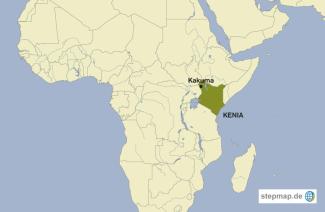Refugee camps
Protecting life and limb

The sprawling Kakuma camp in northwest Kenya is a case in point. The camp and the neighbouring Kalobeyei Integrated Settlement is home to about 197,000 refugees and asylum-seekers from 19 countries, including South Sudan, Sudan, Somalia, the Democratic Republic of Congo, Burundi and Ethiopia.
In this cauldron of different nationalities and cultures, threats can come from both inside and outside the camp. Often the perpetrators are roving bands of non-refugees. “Insecurity is our major problem,” says Malwal Kiir, a refugee leader. “Night-time attackers loot homes, rape women and kill people.”
Major crime strikes the camp several times in a year. A significant factor is Kakuma’s location in a remote area close to poorly defended borders with Uganda, South Sudan and Ethiopia. Violence is often related to the smuggling of firearms from these countries into Kenya.
UNHCR, the UN Refugee Agency which manages the camp, has arranged for Kenya’s government to station policemen in the camp. That has helped somewhat, but has not stopped the crime wave.
Instead, refugees have been forced to become their own guards, particularly after sunset. Residents join together to patrol at night. Among other measures, they ensure that gates between subdivisions of the camp stay locked at night, to stop attackers from moving between the camp’s separate zones.
Similarly, shops and communal markets hire watchmen to protect their businesses. The night guards coordinate with each other and are armed with machetes, sticks and stones. Attackers however are usually armed with AK47 rifles.
In parts of the camp, guards beating drums at night provide warnings to fellow refugees patrolling their blocks that danger is at hand. At the same time, though, the drum-beating notifies thieves and vandals that their presence is known. In some cases these warnings scare the attackers away. But more often than not, looters respond with attacks against the refugee patrols.
Such battles have repeatedly led to refugees being injured or killed. In August 2020, for example, two refugees were ambushed by gunmen in their community. One refugee, a Somali teenager, was killed by gunshots. Another was seriously wounded.
In December 2020, a dispute between a local person from Turkana County in northwest Kenya and a group of refugees led to the death of a male refugee from South Sudan.
Unfortunately, Kakuma is not an exception. Refugee camps across Africa experience similar crime waves. For example, crime is also rampant in the Dadaab camp in eastern Kenya, which has over 210,000 registered refugees and asylum seekers.
The security situation in Dadaab is so severe that Kenya’s government wants to close the camp to protect national security. Although Kenya has policemen stationed there, the policemen are no more effective in Dadaab than their fellow officers are in Kakuma.
So in Dadaab, as in Kakuma and elsewhere, refugees are left to protect themselves against attackers as best they can.
Qaabata Boru is an Ethiopian journalist and former resident of the Kakuma refugee camp in Kenya. He is the founder and editor-in-chief of Kakuma News Reflector (Kanere), a refugee-led online newspaper.
kakuma.news@gmail.com
https://kanere.org/
Normal 0 21 false false false EN-CA X-NONE X-NONE /* Style Definitions */ table.MsoNormalTable {mso-style-name:"Normale Tabelle"; mso-tstyle-rowband-size:0; mso-tstyle-colband-size:0; mso-style-noshow:yes; mso-style-priority:99; mso-style-parent:""; mso-padding-alt:0cm 5.4pt 0cm 5.4pt; mso-para-margin-top:0cm; mso-para-margin-right:0cm; mso-para-margin-bottom:8.0pt; mso-para-margin-left:0cm; line-height:107%; mso-pagination:widow-orphan; font-size:11.0pt; font-family:"Calibri",sans-serif; mso-ascii-font-family:Calibri; mso-ascii-theme-font:minor-latin; mso-hansi-font-family:Calibri; mso-hansi-theme-font:minor-latin; mso-ansi-language:EN-CA; mso-fareast-language:EN-US;}







